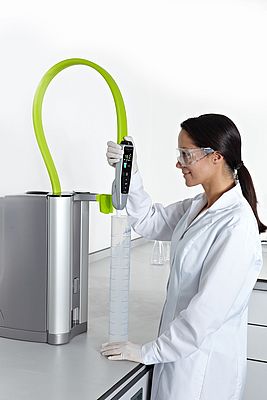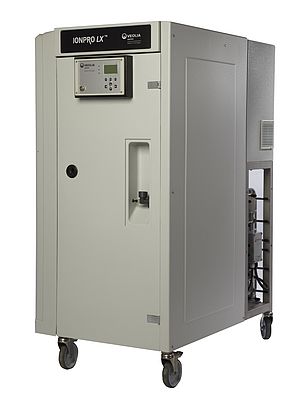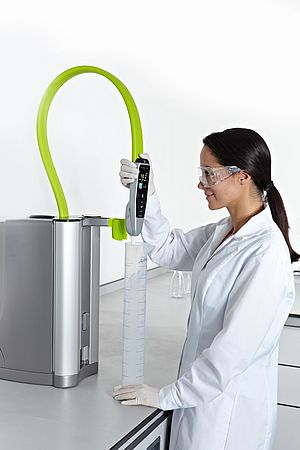In today’s laboratories the availability of pure water for research and testing applications is essential. Elements and compounds present in the parts per billion (ppb) range or lower could negatively affect applications by interacting with samples, active media or system components.
One hundred per cent pure water consists solely of water molecules in balance with hydroxyl and hydrogen ions (10-7M at 25ºC). This composition gives a characteristic electrical resistivity of 18.2 Mohm.cm. However, the unique ability of water to dissolve virtually every chemical compound to some extent and to support practically every form of life means that its purity is constantly under threat from five types of impurities. These are suspended particles; inorganic compounds; organic molecules; dissolved gases; and microorganisms including their associated biomolecules. To generate high purity water for laboratory use, mains drinking water is put through a series of purification steps to remove these different types of impurities.
The purity of type I ultrapure water
The recorded levels of impurities in type I ultrapure water are limited primarily by the sensitivity of the techniques available to measure these and the environment in which the testing takes place. On the basis of current ultra-trace techniques, the maximum levels of non-gaseous impurities present in type I ultrapure water are less than 1.5 μg/l (ppb) for organic compounds and less than 1.0 μg/l for other elements and ions. This means that type I ultrapure water is at least 99.99999975 % pure.
Type I ultrapure water does contain dissolved oxygen and nitrogen at around 9 ppm and 14 ppm, respectively, at 25ºC and 1 bar atmospheric pressure. These could be largely removed by vacuum degassing, however, this procedure is not necessary for most laboratory applications, as the moment that type I ultrapure water comes into contact with air, oxygen and nitrogen dissolve in the water at concentrations in equilibrium with the atmosphere.
Why use Type I Ultrapure water?
Although it may seem extreme to use high purity water, type I ultrapure water does need to be free from all these impurities if it is to be used across the whole range of analytical and experimental applications. Fortunately, this is an economical prospect, with type I ultrapure water only costing around ten pence per litre including all purchase and running costs.
As water may be used in many aspects of an analysis, including preparation of samples, dilutions, standards, and blanks, as eluents and for rinsing instruments, the presence of any contaminants can compromise results. There are numerous ways in which different impurities can affect the reliability and reproducibility of ion chromatography results both in the short and the long term.
High sensitivity analyses are particularly dependent on the high purity of the water, especially when very low concentrations must be measured directly or when only very small samples are available and these need diluting before analysis. Using type I ultrapure water minimises background levels, enabling researchers to obtain highly sensitive results in trace analyses; for example using HPLC.
Maintaining purity
Laboratory workers requiring pure water must bear in mind that the purity of type I ultrapure water can easily become compromised before use if the system itself is inadequately managed or if the water is incorrectly handled during collection and usage.
Of primary importance is maintaining the water purity within the water purifier. The recommended way to achieve this is by protecting the water reservoir from external contamination using a composite vent filter, recirculating the water periodically through the final purification technologies, such as UV photo-oxidation, adsorption and ion-exchange, and regularly sanitising the system as required to minimise bacterial growth.
In normal laboratory use, water is dispensed from a purifier, such as the PURELAB flex, into a vessel. Within seconds the water starts to absorb carbon dioxide from the air forming carbonic acid and reducing the resistivity of the water. Though this carbon dioxide does not degrade the water for most applications, its effect on resistivity can mask the contamination of the water by other ions.
Much more significant for most applications is the risk of contamination as water is dispensed. For example, fixing a length of flexible plastic tubing to purifiers with fixed tap dispensers to make it more convenient to fill carboys or other large containers can cause the water to become contaminated. Organic release agents or plasticisers from the tubing can leach into the water:
It is also important that air entrainment is minimised when type I ultrapure water is dispensed, as impurities in the air can also reduce the water’s purity. Analysis using ion chromatography clearly showed that negative ions, particularly nitrite ions, were detected at higher concentrations when splashing had occurred.
To maximise its purity, type I ultrapure water should be used soon after it is dispensed. Analysis results also suggested that glass bottles were preferable for storing water to plastic wash-bottles. Similar contamination problems can occur if bottled purified water for high sensitivity analysis is stored and reused after opening.
Conclusion
The extremely high purity of type I ultrapure water enables laboratory workers to obtain accurate results from high sensitivity analyses. This analytical accuracy is dependent, however, on the use of a well designed water purification system to maintain and monitor the water’s purity within the system, easy to use water dispensing and good laboratory practise during collection and use.
Author: Dr Paul Whitehead, CChem, FRSC Laboratory Manager, ELGA R&D Facility
Type I ultrapure water
How to get the best results from ultrapure water
- by ELGA Process Water
- October 4, 2011
- 199 views



















